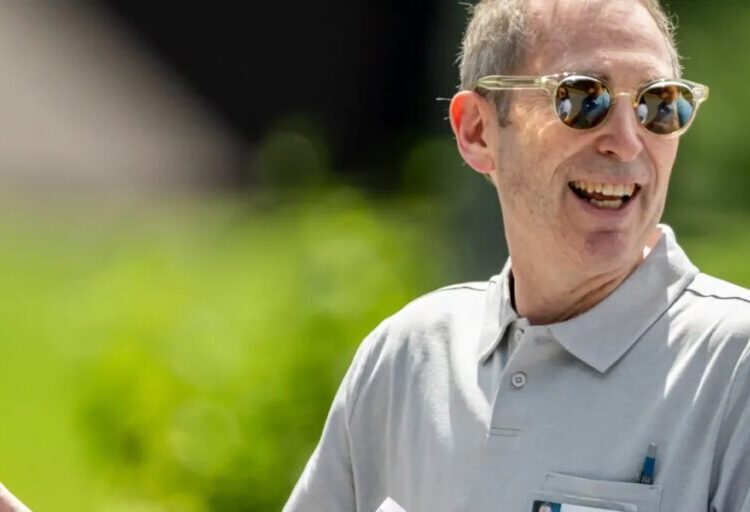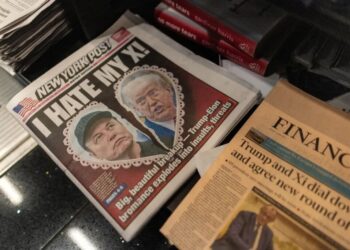Suisun City is a town of 30,000 in a neglected corner of the San Francisco Bay Area. Its two most prominent features are its marshy waterfront and its lack of money.
The local government has spent the past several decades ping-ponging between the threat of insolvency and revitalization plans that work for a time and then fizzle out. Walking through the 19th-century downtown, past historic brick buildings with boarded-up windows and a redeveloped park where homeless people sleep, you see a city with good bones that wishes to be more, but can’t seem to figure out what.
Enter Suisun City’s latest bid for renewal: a proposal to annex 22,873 acres of agricultural land owned by a company called California Forever, a development play backed by a group of Silicon Valley billionaires. California Forever’s hope is to build a new, up-from-the-ground city on yellow hills dotted with sheep and wind turbines.
The point of the Suisun annexation is for each side to help the other solve a problem. California Forever’s problem is that it wants to build on unincorporated land in Solano County, which has a law forbidding the building of much of anything outside established cities. Suisun’s problem is that it is broke.
If the idea is approved, Suisun would absorb California Forever’s land, turning the rural plot into a developable area — all while expanding Suisun’s footprint and securing a gusher of future tax revenue if and when anything ever gets built.
“This is a once-in-a-generation opportunity,” Alma Hernandez, the mayor of Suisun, told me in a recent interview.
California Forever has been provoking superlatives, good and bad, since the project was revealed two years ago. The company’s long-term plan is to build a walkable city of up to 400,000 people, about an hour north of San Francisco, with a manufacturing center and nearby shipbuilding facility along the Sacramento River. Renderings show a Brooklyn-esque neighborhood packed with three-to-five-story buildings surrounded by parks, plazas and farmers’ markets.
Because the idea is so big and audacious, and its backers so rich, the reaction for and against the project has been supercharged. Boosters say it could transform the region’s economy, revive the middle class and stanch the outflow of businesses from California to neighboring states. Skeptics say it would eviscerate farmland and turn a quaint community into the civic equivalent of a shell company beholden to tech moguls.
Late last month, when Suisun hosted a community meeting in a local event space to discuss the proposal, there were baskets of Oreos and Nutter Butters along with four policemen stationed across the room. The meeting began with calls for respect and civility. The shouting began shortly after.
“I’m of the opinion that this is a scam,” said Andrew Russo, a retired civil servant who lives in downtown Suisun and was sitting near the front in a white fedora.
“The door is right there,” said Bret Prebula, the city manager of Suisun, after other hecklers joined in.
“The door is there for you, too!” Mr. Russo replied.
“All the people who are young enough to work are interested in hearing about the opportunity,” Alicia Mijares, the business representative for a local sheet metal workers’ union and a supporter of the project, shouted across the room at Mr. Russo.
“Opportunities!” Mr. Russo guffawed back at her. “You think they care about you?”
As the room devolved into arguments and side chatter, Mr. Prebula took the tone of an angry teacher with an unruly class.
“If this happens again, we’re done,” he said.
An Inauspicious Beginning
To understand how a plan this big and contentious landed in Suisun — a city that The San Francisco Chronicle once rated as the worst place to live in the Bay Area — you need to know a bit of its crazy back story. It goes like this.
In 2017 a mysterious company called Flannery Associates started amassing farmland in an eastern corner of Solano County. Flannery had no known business, shareholders or employees, yet in the space of a few years it spent about $950 million on about 70,000 acres, an area twice the size of San Francisco.
Everyone knew it was a front, but couldn’t figure out for what. Chinese spies? A new Disneyland?
The truth turned out to be even stranger: billionaires with plans to build an urbanist’s fever dream from scratch.
The company is run by a former Goldman Sachs trader named Jan Sramek, and his investors are a who’s who of Silicon Valley. They include Michael Moritz and Marc Andreessen, both venture capitalists; Reid Hoffman, the co-founder of LinkedIn; Laurene Powell-Jobs, the widow of the Apple co-founder Steve Jobs; and Patrick and John Collison, the sibling founders of the payments company Stripe.
After The New York Times revealed the company’s intentions and funders in 2023, California Forever was born, and Mr. Sramek began selling his plan. Locals responded by calling it “oligarch city” and starting groups like Solano Together and Califorina4Never.
Assuming California Forever is like every other decades-long construction venture, the plans will change over time and many of the people talking about them today will be dead before it’s completed. So what the company is really asking locals for is their trust. And, as the fractious meetings show, this has yet to be fully earned.
The most frequent point of contention is the company’s past deception: How can you trust a group that spent years suggesting to local officials that Flannery/California Forever was a passive buyer of farmland? There are also the company’s hardball tactics, such as suing a group of holdout farmers in a $510 million antitrust case.
In the beginning, Mr. Sramek’s pitch was heavily centered on addressing California’s housing shortage, and it seemed that anytime he showed up at a meeting all anyone did was yell at him. Today, however, while California Forever still wants to build housing, its emphasis has shifted toward developing a local factory sector, and the reaction has gone from almost entirely negative to more mixed.
There are still a lot of shouters like Mr. Russo. But the company has become a local power player with Solano offices and Solano employees. Both California Forever and Suisun City have signed agreements to use local trade unions on future work, hence the contingent of cement masons and sheet metal workers who showed up to the recent meeting in hats bearing the names of their locals.
After the meeting ended, Bob Megary, 72, walked across the street to a stool in Lucy’s, a spare and hard-looking bar on Main Street, the sort of place where everyone looks in unison at whoever walks through the door. Mr. Megary is a retired ironworker who moved to Suisun for a $200,000 house and spent his career racking up miles of road and hours of sports radio driving to job sites in San Francisco and Silicon Valley. That’s a typical arrangement in Solano, which is the Bay Area’s lowest-income county.
Mr. Megary is so enthusiastic about California Forever’s project that he has become a paid ambassador whose job is to evangelize its benefits to blue-collar workers like him.
“This what we need to keep our kids here,” he said of the project.
Should Suisun Be a City?
A longstanding question in Solano County is whether Suisun is capable of being city at all. The town is perennially strapped and sits next to the larger city of Fairfield (population: about 120,000). A half-century ago there were discussions about combining the two neighbors, and in the decades since Suisun officials have argued again and again that they are just one project away from financial stability.
First it was a new subdivision on the edge of town. Then it was the Walmart Supercenter and high hopes for cannabis taxes. Each project was followed by a budget crunch and lamentations. The receipts did not live up to the hype.
“This city, honestly, if you really look at its history, it should have not survived up until now,” Mayor Hernandez said.
Her City Hall office looks out on the tall grasses and bobbing boats in the Suisun Slough, which connects to the San Francisco Bay and made the area a local shipping center in the late 1800s. It is in a white building with a glass dome that was put up in 1989 when the city was briefly flush.
Thanks to state redevelopment funds, the city was able to build the government complex (the previous City Hall was a trailer) that connects to a waterfront park where people cast fishing lines in the slough. But the redevelopment program didn’t spark the economy as much as people hoped, and the city has struggled with upkeep. Last year, with the city’s finances bleeding out, voters approved a new sales tax. Had it failed, Suisun may have had to dissolve as a city.
During a recent tour of downtown Ms. Hernandez thanked me when I bought an ice cream sandwich and again when I bought a comic book. Along the way, as we passed sights like an out-of-business smoke shop and empty lots wrapped in cyclone fencing, she argued that the city’s money problems stemmed from decades of being boxed in. There’s a marsh on one side, Fairfield on another and Travis Air Force Base next to that. When California Forever announced its plan to build east of the city, Ms. Hernandez said, she took it for granted that Suisun would get encroached on again.
Instead it created an opportunity. California Forever’s original plan was to run a ballot initiative that, if passed, would carve a hole in the county law prohibiting development of agricultural land. The polling was bad, and the proposal was pulled before the election. A few months later Mr. Prebula, the city manager, reached out to ask about a possible annexation, which is now called the Suisun Expansion Plan.
“Suisun is a city that wants to not just talk about jobs and homes, but actually deliver them,” Mr. Sramek said.
Suisun is merely exploring the idea, with California Forever paying for the various consultant reports and environmental studies that have to be completed before the proposal can be voted on. The final approval would come from the Local Agency Formation Commission, the body that decides the borders of cities in Solano County.
This is all years away in a story that is certain to have many more twists. But, for now, Ms. Hernandez said it felt nice to be reaching for the future instead of always defending the past.
“It’s a little city recognizing that it has leverage,” she said.
Conor Dougherty covers housing and development, focusing on the rising costs of homeownership. He is based in Los Angeles.
The post A City Is Broke. Can a Billionaire’s Urbanist Dream Offer It a Last Chance? appeared first on New York Times.




